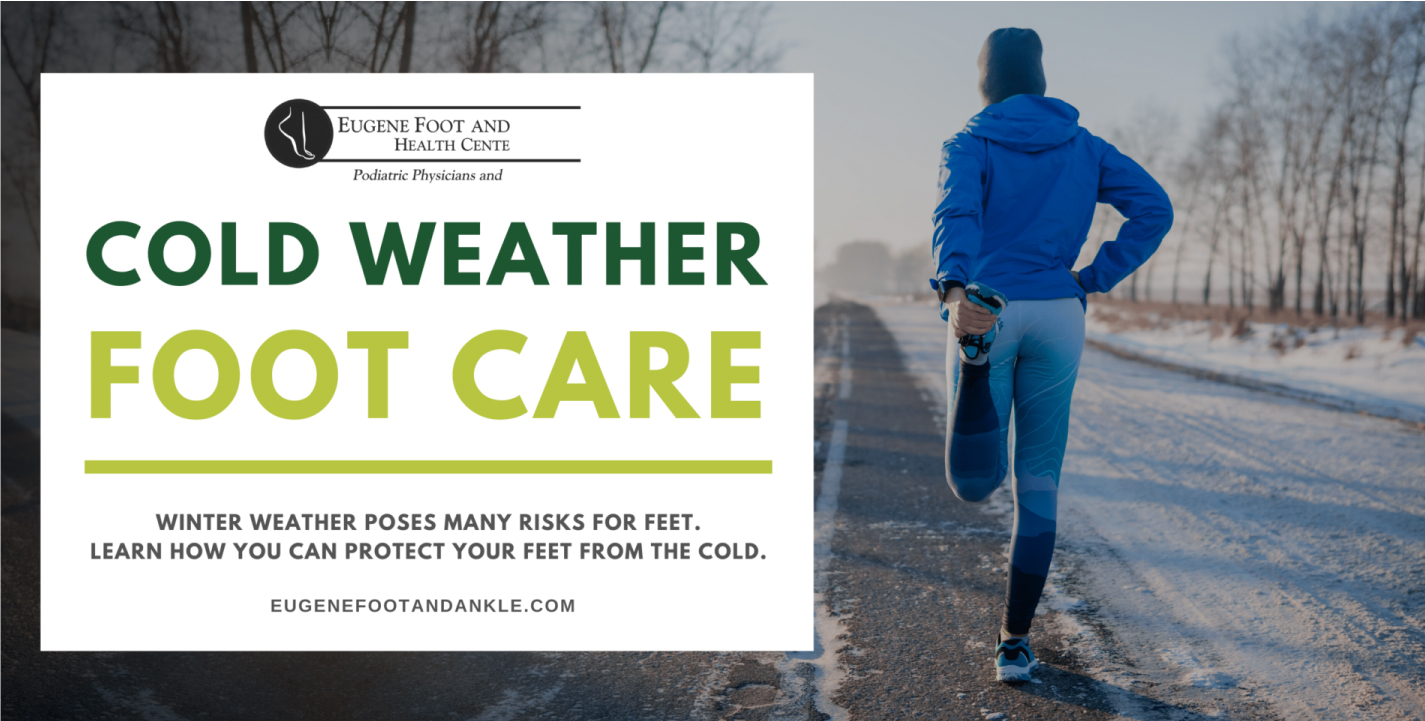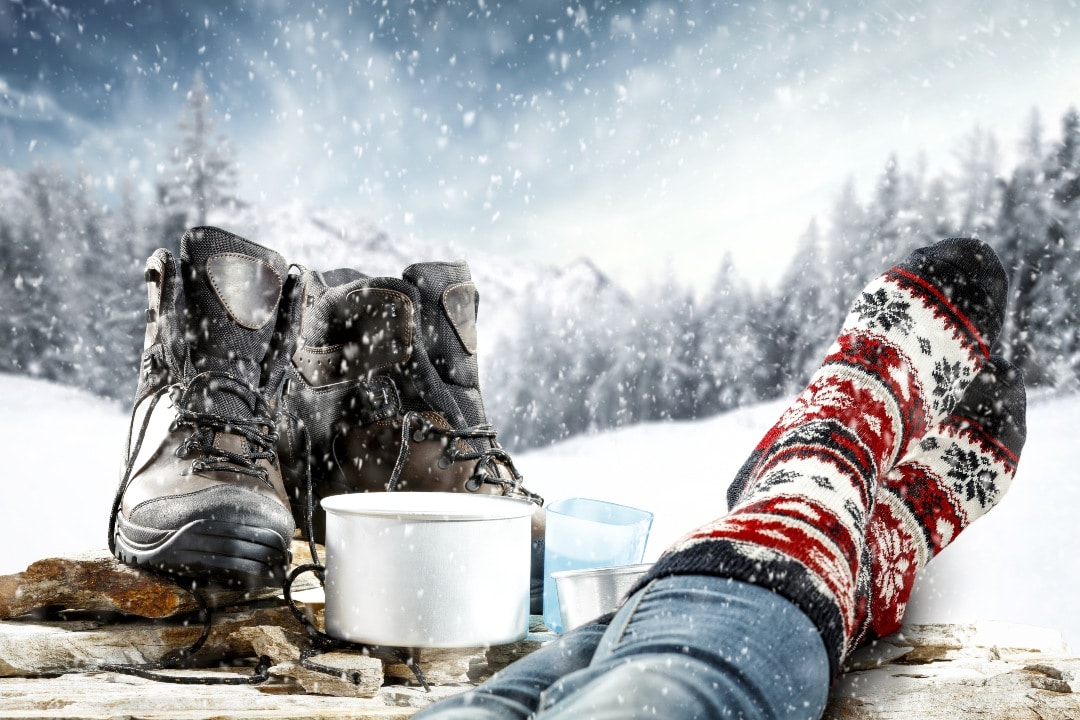Cold Weather Foot Care
Here in Eugene, the Pacific Ocean protects us somewhat from the extreme wind chills and heavy blankets of snow that our more inland neighbors must put up with. But that doesn’t mean it isn’t still going to get chilly, wet, and unpleasant for a good chunk of the next several months. Foot care is still an important factor to keep in mind. If you don’t play it smart, that could mean nasty repercussions for your feet.
From accidental injuries to damaged nails and skin, the winter weather increases your risk of developing several unpleasant foot and ankle conditions. Fortunately, preventing them doesn’t have to be hard; you just need to be mindful.

Winter-Related Foot Conditions
Some of the most common seasonal foot care issues we see at our office include:
- Slips and falls. Rainy, cold winters can really present a slipping hazard on the coldest days of the year. Water on top of ice is about the most hazardous walking surface you can imagine. And while, most of the time, a tumble on the ice only hurts your pride, more serious injuries (such as sprained or broken ankles) are relatively common.
- Temperature-related injuries. How much cold exposure is required before frostbite threatens to take a toe? A lot less than you might think—especially if your feet are wet or there is even a moderate amount of wind. In many cases, 30 minutes of exposure is more than enough.
- Fungal or bacterial skin infections. Keeping your feet encased in fuzzy socks and heavy boots might keep them nice and toasty, but may also lock in moisture and keep your feet excessively wet and sweaty. Possible downsides include smelly foot odor, athlete’s foot, or a fungal nail infection.
- Dry and cracked skin. The flipside is that things like dry indoor heat and even hot showers draw moisture out of your skin. We probably don’t have to tell you that dry, cracked skin is at best unsightly and uncomfortable. But did you know that, if the fissures are severe, you could even experience bleeding and infection? If you have diabetes, this is especially risky.
- Winter sports injuries. Plenty of our patients are winter sports enthusiasts—and really, with great ski slopes within an easy drive, it’s no surprise. While we encourage you to get active and enjoy yourself, there’s always a risk of injuries.

How to Protect Your Feet in Winter
So now that you know some of the risks, what can you do about them? Here are some of our key tips, broken down by category:
Socks
In winter, you’ll likely want to switch to somewhat heavier socks to provide extra warmth. At the same time, you don’t want to trap moisture.
Moisture-wicking fabrics like wool are generally a good strategy. If it’s really cold, you might consider wearing a thinner, moisture-wicking “liner” sock underneath a thicker pair.
Remember to change your socks when they get damp, even if that means multiple times per day. After being out for a while, it’s good to take them off and let your feet dry out a bit before putting on a new, clean pair.
Shoes & Boots
In a place with very wet winters (as we have here in Oregon), waterproof footwear is a must for those rainy, slushy, sleety winter days. Don’t try to get away with thin shoes or sandals that can’t shut out the cold.
Of course, wearing heavy waterproof boots all the time also means your feet might get a bit hot and sweaty when you’re out wearing them for a while.
A couple of suggestions here: First, have a couple of different pairs of winter boots that you can rotate every other day, as this gives each pair more time to dry. Second, you may want to take along a more normal pair of shoes you can switch into at work or wherever you plan to be inside for an extended period of time. Third, consider using foot powder inside your shoes and on your feet to keep them dry and odor-resistant.
We also need to talk about fit. Like any pair of shoes, your winter boots need to be the right size, provide good shock absorption, and support for your arch. Ill-fitting boots are a recipe for pain, blisters, and all manner of frustrating foot care problems.
Just remember the width of your sock when trying boots on at the store! A pair that fits your feet perfectly when wearing thin, nylon socks will probably be too small for your thick, winter wool. Make sure you take socks of the appropriate thickness with you to the shoe store.
Hygiene & Skin Care
Keep your feet nice and clean by taking regular baths or showers and making sure you give your feet some attention. Avoid excessively hot water—it may feel good for a few minutes, but as we said before, scalding showers actually dry your skin out.
We also strongly recommend you apply a foot cream or moisturizer daily—especially if you have diabetes or are especially prone to getting dry feet. Doing so right after you bathe or just before bed, then putting on a nice fresh pair of socks, is a good strategy and goes a long way in terms of foot care. Just make sure you avoid the area between the toes!
Injury Prevention
Once again, wearing the right socks and boots—and appropriate safety gear overall—will go a long way toward keeping your feet healthy and safe if you’re out and about.
Whether you’re just trying to get from the house to your car, or keeping up with your daily run, make sure to take it slow and steady in wintry conditions.
Runners: now is not the time to set your new PR! Make sure you’ve got good soles with good traction, slow down your pace, and shorten your stride to avoid taking a nasty tumble. And of course, use good judgment—if conditions are too cold or too slick to stay outside for long, then stay inside and work on some low-impact cardio instead.
If you like to ski, snowboard, or do any other outdoor winter sports, again, make sure you’ve got proper safety gear and dress appropriately!
Address Winter Foot Concerns Promptly
Cold-weather conditions and injuries can quickly make your season miserable. Without prompt attention, some may even snowball into much more serious foot care problems.
So, if your feet are bothering you this winter, make sure you set an appointment with us at Eugene Foot and Ankle Health Center right away. We’ll make sure your feet get back to full health, so you can go back to making the most of this and every season of life!
To schedule, give us a call at (541) 683-3351, or request an appointment using our contact form.
Contact Us
Eugene
P: (541) 683-3351
F: (541) 683-6440
Hours:
Monday............ 8:00am - 5:00pm
Tuesday............ 8:00am - 5:00pm
Wednesday............ 8:00am - 5:00pm
Thursday............ 8:00am - 5:00pm
Friday............ 8:00am - 4:00pm (Only available on phones)
Closed for lunch from 12pm - 1pm and closed until 1:30pm on Tuesdays
© Copyright 2024 Eugene Foot and Ankle. All Rights Reserved. | Privacy Policy.
